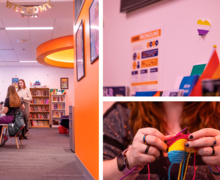Syracuse must recognize rape culture on campus affects POC students differently
Cassandra Roshu | Staff Photographer
Rape culture affects each individual differently based on the structural intersectionality of race and gender.
Rape and sexual assault culture in college is not a new phenomenon. But many colleges are not proactive about acknowledging its presence on campus — they don’t educate students on consent and what constitutes sexual assault and often don’t offer spaces to talk about ways campus culture can enforce rape culture further. Universities also can’t address rape culture through the same lens for everyone, it’s especially different for people of color. Rape culture, and how society treats a victim, can vary depending on the individual.
This conversation is especially necessary for Syracuse University because it’s a predominantly white institution. SU needs to realize that the culture of rape and assault on campus affects POC communities differently. Prioritizing inclusive data on the background of a victim can be the first step on how to implement policies that are effective.
Studies have shown that 26.4% of female undergraduate students report some form of sexual assault in American universities and 90% of assaults are done by those who are close to the victim or in the victim’s circle. Out of this 26.4%, it is not clear from the data collected what percent are women of color. However, research shows that about 18% of Black women in the United States will experience some sort of assault in their lifetime.
Conversations about rape culture and its effects on a community must demonstrate the intersection of race and gender. Keeping in mind structural intersectionality is a key way to support Black and Indigenous People of Color in higher education who are facing rape culture. Structural intersectionality considers that women of color experience violence differently from white women. For women of color, discussing rape culture in higher education is not just a matter of sexism, but also racism.
Historically, Black women in particular who face sexual violence function under the space of misogyny and discrimination of both their gender and race. The long history of hypersexualizing Black women has affected their safety. This has ripple effects in authorities believing the victim and the perpetrator are less likely to be arrested or face charges. Black and brown victims already have a preconceived notion of police, and are met with microaggressions if they decide to report their assault.
There is limited data available to understand the number of BIPOC women on college campuses who experience assault. This deprives students of proper policies and resources if they report their assault. When women do report their assault, universities are not required to include a student’s race and ethnicity in Title IX reports. This information is vital to create better environments for BIPOC students on campus.
Current approaches to rape culture do not consider intersectionality. These approaches place all victims under the umbrella of white experiences, which do not benefit all people. There needs to be spaces for students to understand the causes of rape culture, while also including how it harms different communities in different ways. Syracuse University can include educational spaces or new curriculums implemented in classes such as First Year Seminar, can help students understand how to report an assault and what that process may look like.
SU must prioritize creating a safe environment on campus where students feel comfortable reporting their assault. A survey given to undergraduate students on campus in 2020 gives insight into the percentage of student’s who are aware they can seek help from the campus (70%), a percentage of students who have been assaulted, in a violent or abusive relationship (24%) and student’s who have a general understanding of procedures and resources for sexual assault on campus (65%).
The university is currently administering its 2022 survey to collect information regarding assault on campus. But the results still do not answer questions on whether students feel safe to report their assault or if the university can provide policies to ensure safety for the victims. Also, out of the 4,000 students randomly selected to fill out the 2020 survey, only 29% responded. It is important for students to fill out this upcoming survey to spark more urgency in SU leadership to prevent sexual assault on campus by proving policies that are beneficial to all students on campus.
Sarhia Rahim is a Sophomore Policy Studies Major. Her Column appears bi-weekly. She can be reached at slrahim@syr.edu.
Published on November 8, 2022 at 10:52 pm






